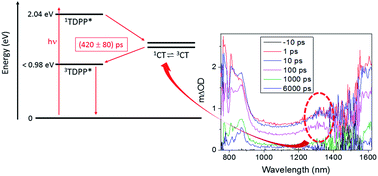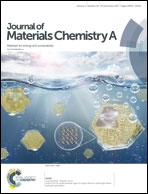Ultra-fast spin-mixing in a diketopyrrolopyrrole monomer/fullerene blend charge transfer state†
Abstract
Diketopyrrolopyrrole (DPP) is one of the most common building blocks for small molecules and conjugated polymers designed for organic electronic applications. By attaining a detailed understanding of the photophysical behaviour for a simple DPP-based molecule in fullerene blends, we establish a foundation for spectroscopic investigations into more complex DPP-based systems. Transient absorption spectroscopy (TAS) and time-resolved electron paramagnetic resonance (TR-EPR) spectroscopy are used to examine bulk heterojunction blend films of a small diketopyrrolopyrrole-based molecule, 2,5-bis(2-hexyldecyl)-3,6-di(thiophen-2-yl)-2,5-dihydropyrrolo[3,4-c]pyrrole-1,4-dione (TDPP) with the common fullerene derivatives [6,6]-phenyl-C61-butyric acid methyl ester (PC60BM) and [6,6]-phenyl-C71-butyric acid methyl ester (PC70BM). Following pulsed laser excitation, the spectral signatures of a fullerene anion and a TDPP triplet state are observed on the picosecond timescale by TAS. The presence of these species implies the formation of a TDPP:PCBM charge transfer state that subsequently undergoes ultra-fast spin-mixing and geminate recombination to produce a TDPP triplet state. The overall photophysical mechanism is confirmed by TR-EPR spectroscopy, which unambiguously shows that the TDPP triplet is formed via spin-mixing in the TDPP:PCBM charge transfer state, rather than direct intersystem crossing from the excited singlet state.



 Please wait while we load your content...
Please wait while we load your content...